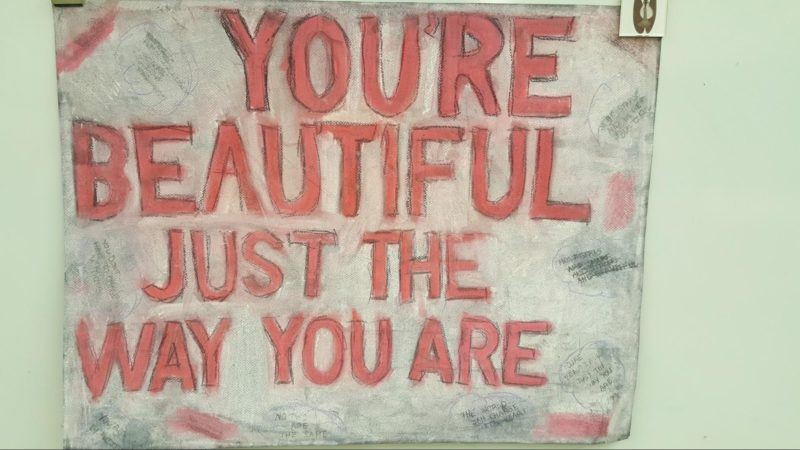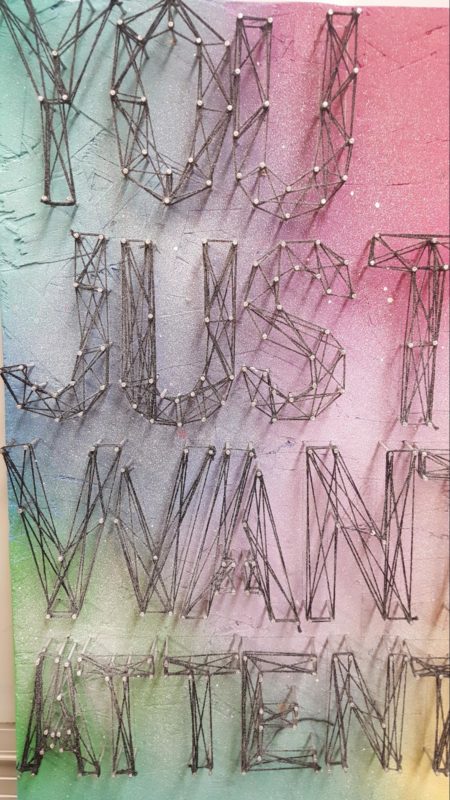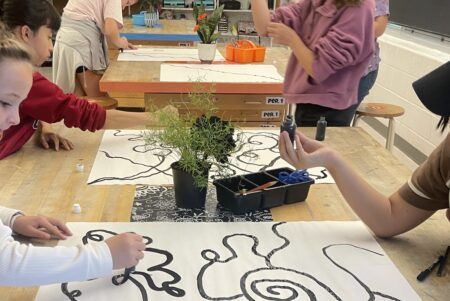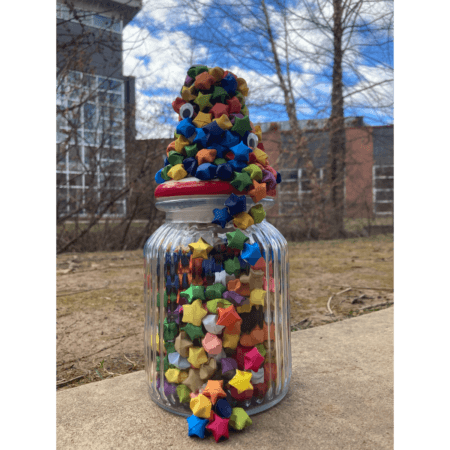Teaching with Contemporary Art
Teaching with the Power of Words

Anonymous student artwork. Photo by Alex Mendez.
Growing up bilingual, I have always been fascinated by words. For as long as I can remember, I have been inspired by the power of words to create meaning. Learning a second language revealed to me something that proved to be a unique relationship with text and meaning. While learning to speak English, I was inspired by the colors and typography of graffiti. That is when I began to understand how words can be used to create art.
Teaching with examples of contemporary artists who use text as part of their art requires dialogue and discussion about meaning and intent. Students often don’t see words as possible materials or subject matter for art. Showing students the different ways that some artists incorporate text into their work helps them to see the possibilities of doing something similar in their own art. To help students analyze what the artists are doing, I often ask two questions: How do these artists use text in their work? What role does text play in their work? I want students to discover how words can have power in the art that they make and to find the best way to show it.
Teaching students from kindergarten through twelfth grade, I seek out ways to incorporate the use of text in art making. The great resource of artists featured by Art21 has been a valuable teaching tool in my classroom. There are many artists who use text in unique ways. Glenn Ligon talks about using other people’s words to make meaning:
At a certain moment I decided that being an Abstract Expressionist wasn’t quite gonna do it [for me], and that produced a kind of crisis in the studio. What I decided to do was to incorporate the things that I was thinking about, the things that I was reading, into the work directly. And the models for that were people like Jasper Johns and Robert Rauschenberg, people who would use text in their work. When I first started doing that, I decided I was just going to use my own handwriting, and then after a while I decided that I am not interested in telling my own stories; I am interested in what other people have to say. There is nothing wrong with self-expression; it just has its limits. The things that I was interested in were already in the world. They didn’t need me to create them again in that way. They just needed for me to have them be brought into the work.
When Ligon discusses using other people’s ideas to make his art, this helps to challenge students’ thinking about what they think art should be. After being exposed to Ligon’s work, many students turn to experimenting with literature, song lyrics, and poetry in their art. These are all things that students are engaged with on a regular basis, and it helps them to see that it is okay to incorporate their interests in their art.

Anonymous student artwork. Photo by Alex Mendez.
When teaching about the use of text, I ask students the following questions: What is the purpose of words? What kind of power do words have? What role do words play in your life? How can words be used to make art? How can words and art be used together? These questions help students to think through the possibilities of combining text and images in their art. Mark Bradford is another artist who helps students to further understand these questions. I show students the Art21 segment in which he talks about repurposing signs and posters from his community to make art. Bradford focuses on the shapes, iconography, and ephemera of the text to construct his large-scale works. In some of his works, text plays a minor role, but he still finds different ways to use it. I make sure that I show students the segment in which Bradford discusses his early use of handwriting in his art:
I made the signs of the prices in my mom’s hair salon. I taught myself to do calligraphy so that I could make them very fancy on the wall. So the hand was [present] very early in my work—but not perfect, and [the letters] always got a little slimmer at the end [of a line] because I wouldn’t measure it properly.
After watching the segment on Mark Bradford, students are fascinated with his approach to making art from repurposed signs and materials that are sourced from his community. At this point, students start to understand how they can manipulate text to their benefit.

Anonymous student artwork. Photo by Alex Mendez.
Barbara Kruger and Jenny Holzer both use text as the major inspiration and primary source material for their work. The work of these artists requires that one read the message in the context that it is displayed. Both of these artists take great care in how words are displayed and focus on the messages that are presented. Showing students works by Holzer and Kruger helps them to see how working with meaning specifically through text can play out in the making of art. The powerful messages that these artists create appear in many different formats. The works range widely, from large bold text surrounded by a red background, installed on a wall, a skate park, or a gallery floor, to poems or statements projected onto buildings or displayed in electronic signage. The work sometimes appears like an advertisement for a product but then encourages the viewer to engage with the work by reading or spending time with the text. Barbara Kruger’s perspective on text as art comes from a personal understanding:
How come any piece of canvas with pigment on it gets to be called art? There are so many ways of making art. Some of them are more available to a general public than others. I remember going to galleries when I was young, totally intimidated. Certain work has to be decoded. To me, the availability of my work was important because I was that viewer who didn’t understand, who didn’t know the codes.
Both Kruger and Holzer make it a point to engage the viewer in reading the text being used. Students respond to these artists’ works because they can read and understand the literal meaning of the text and at the same time enjoy the creative ways that these artists relay their messages through large projections, LED screens, and signage installations.

Anonymous student artwork. Photo by Alex Mendez.
I share many different ways that contemporary artists use text in their work to encourage students to think differently about using text as a primary source material for their own art. After learning about these ideas, many students prefer simply to use lyrics from songs by their favorite musicians in an illustrative approach. Other students consider how words can be manipulated and altered to create art that contains text but may not be something that can be easily read. For many students, using text in art becomes a liberating event, in which they can think outside of conventions and experiment with an idea. Teaching with examples of text-based art has challenged some students to think about what art can be, and it has led to careful reconsideration about the power that words have in written form, in spoken form, and in the form of art.
Watch Alex’s playlist, “Teaching with the Power of Words.”



